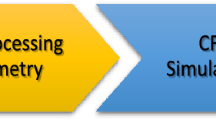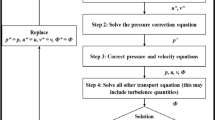Abstract
A mathematical model is constructed to examine the characteristics of three layered blood flow through the oscillatory cylindrical tube (stenosed arteries). The proposed model basically consists three layers of blood (viscous fluids with different viscosities) named as core layer (red blood cells), intermediate layer (platelets/white blood cells) and peripheral layer (plasma). The analysis was restricted to propagation of small-amplitude harmonic waves, generated due to blood flow whose wave length is larger compared to the radius of the arterial segment. The impacts of viscosity of fluid in peripheral layer and intermediate layer on the interfaces, average flow rate, mechanical efficiency, trapping and reflux are discussed with the help of numerical and computational results. This model is the generalized form of the preceding models. On the basis of present discussion, it is found that the size of intermediate and peripheral layers reduces in expanded region and enhances in contracted region with the increasing viscosity of fluid in peripheral layer, whereas, opposite effect is observed for viscosity of fluid in intermediate layer. Final conclusion is that the average flow rate and mechanical efficiency increase with the increasing viscosity of fluid in both layers, however, the effects of the viscosity of fluid in both layers on trapping and reflux are opposite to each other.
Similar content being viewed by others
References
Shapiro A H, Jaffrin M Y, Weinberg S L. Peristaltic pumping with long wavelengths at low Reynolds number. Journal of Fluid Mechanics, 1969, 37, 799–825.
Chaturani P, Upadhya V S. A two-fluid model for blood flow through small diameter tubes. Biorheology, 1979, 16, 109–118.
Chaturani P, Upadhya V S, Mahajan S P. A two-fluid model for blood flow through small diameter tubes with non-zero couple stress boundary condition at interface. Biorheology, 1981, 18, 245–253.
Chaturani P, Biswas D. Three-layered Couette flow of polar fluid with non-zero particle spin boundary condition at the interfaces with applications to blood flow. Biorheology, 1983, 20, 733–744.
Shukla J B, Parihar R S, Rao B R P, Gupta S P. Effects of peripheral-layer viscosity on peristaltic transport of bio-fluid. Journal of Fluid Mechanics, 1980, 97, 225–237.
Brasseur J G, Corrsin S, Lu N Q. The influence of peripheral layer of different viscosity on peristaltic pumping with Newtonian fluids. Journal of Fluid Mechanics, 1987, 174, 459–519.
Srivastava L M, Srivastava V P. Peristaltic transport of a two-layered model of physiological fluid. Journal of Biomechanics, 1982, 15, 257–265.
Chaturani P, Ponnalagarsamy R. Pulsatile flow of Casson’s fluid through stenosed arteries with applications to blood flow. Biorheology, 1986, 23, 499–511.
Sharan M, Popel A S. A two-phase model for flow of blood in narrow tunes with increased effective viscosity near the wall. Biorheology, 2001, 28, 415–428.
Ponalagusamy R. Blood flow through an artery with mild stenosis: A two layered model, different shapes of stenoses and slip velocity at the wall. Journal of Applied Science, 2007, 7, 1071–1077.
Pralhad R N, Schultz D H. Two-layered blood flow in stenosed tubes for different diseases. Biorheology, 1988, 25, 715–726.
Srivastava V P, Saxena M. Two-layered model of Casson fluid flow through stenotic blood vessels: Applications to the cardiovascular system. Journal of Biomechanics, 1994, 27, 921–928.
Srivastava V P, Saxena M. A two-fluid model of non-Newtonian blood flow induced by peristaltic waves. Rheologica Acta, 1995, 34, 406–414.
Haldar K, Andersson H I. Two-layered model of blood flow through stenosed arteries. Acta Mechanica, 1996, 117, 221–228.
Rao A R, Usha S. Peristaltic transport of two immiscible viscous fluids in circular tube. Journal of Fluid Mechanics, 1995, 298, 271–285.
Usha S, Rao A R. Peristaltic transport of two-layered power-law fluids. Journal of Biomechanical Engineering, 1997, 119, 483–488.
Misra J C, Pandey S K. Peristaltic transport of a non-Newtonian fluid with a peripheral layer. International Journal of Engineering Science, 1999, 37, 1841–1858.
Misra J C, Pandey S K. Peristaltic flow of a multilayered power law fluid through a cylindrical tube. International Journal of Engineering Science, 2001, 39, 387–402.
Misra J C, Pandey S K. Peristaltic transport of blood in small vessels: Study of a mathematical model. Computers and Mathematics with Applications, 2002, 43, 1183–1193.
Mishra M, Rao A R. Peristaltic transport of a channel with a porous peripheral layer: Model of a flow in gastrointestinal tract. Journal of Biomechanics, 2005, 38, 779–789.
Elshehawey E F, Gharsseldien Z M. Peristaltic transport of three-layered flow with variable viscosity. Applied Mathematics and Computation, 2004, 153, 417–432.
Pandey S K, Chaube M K, Tripathi D. Peristaltic transport of multilayered power-law fluids with distinct viscosities: A mathematical model for intestinal flows. Journal of Theoretical Biology, 2011, 278, 11–19.
Sankar D S, Lee U. Two-fluid Casson model for pulsatile blood flow through stenosed arteries: A theoretical model. Communications in Nonlinear Science and Numerical Simulation, 2010, 15, 2086–2097.
Srivastava V P, Rastogi Rati. Blood flow through a stenosed catheterized artery: Effects of hematocrit and stenosis shape. Computers and Mathematics with Applications, 2010, 59, 1377–1385.
Ponalagusamyn R, Selvi R T. A study on two-layered model (Casson–Newtonian) for blood flow through an arterial stenosis: Axially variable slip velocity at the wall. Journal of the Franklin Institute, 2011, 348, 2308–2321.
Tripathi D. Peristaltic flow of couple-stress conducting fluids through a porous channel: Applications to blood flow in the micro-circulatory system. Journal of Biological Systems, 2011, 19, 461–477.
Tripathi D. A mathematical model for the peristaltic flow of chyme movement in small intestine. Mathematical Biosciences, 2011, 233, 90–97.
Tripathi D. Peristaltic transport of fractional Maxwell fluids in uniform tubes: Application of an endoscope. Computers and Mathematics with Applications, 2011, 62, 1116–1126.
Tripathi D, Pandey S K, Das S. Peristaltic flow of viscoelastic fluid with fractional Maxwell model through a channel. Applied Mathematics and Computation, 2010, 215, 3645–3654.
Tripathi D. A mathematical model for swallowing of food bolus through the oesophagus under the influence of heat transfer. International Journal of Thermal Sciences, 2012, 51, 91–101.
Author information
Authors and Affiliations
Corresponding author
Rights and permissions
About this article
Cite this article
Tripathi, D. A Mathematical Study on Three Layered Oscillatory Blood Flow Through Stenosed Arteries. J Bionic Eng 9, 119–131 (2012). https://doi.org/10.1016/S1672-6529(11)60104-2
Published:
Issue Date:
DOI: https://doi.org/10.1016/S1672-6529(11)60104-2




